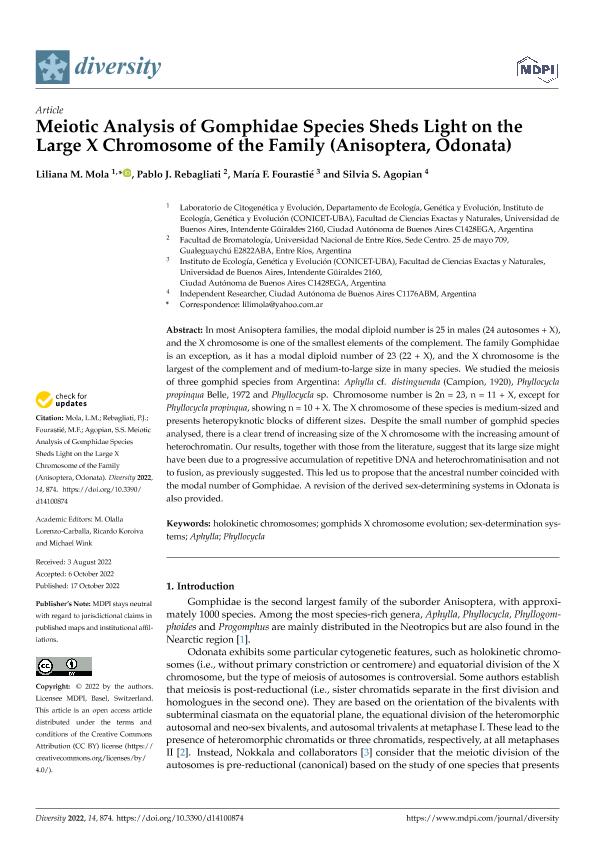Mostrar el registro sencillo del ítem
dc.contributor.author
Mola, Liliana Maria

dc.contributor.author
Rebagliati, Pablo Javier

dc.contributor.author
Fourastié, María Florencia

dc.contributor.author
Agopian, Silvia S.
dc.date.available
2023-10-04T14:17:51Z
dc.date.issued
2022-10
dc.identifier.citation
Mola, Liliana Maria; Rebagliati, Pablo Javier; Fourastié, María Florencia; Agopian, Silvia S.; Meiotic Analysis of Gomphidae Species Sheds Light on the Large X Chromosome of the Family (Anisoptera, Odonata); MDPI; Diversity; 14; 10; 10-2022; 1-17
dc.identifier.issn
1424-2818
dc.identifier.uri
http://hdl.handle.net/11336/214083
dc.description.abstract
In most Anisoptera families, the modal diploid number is 25 in males (24 autosomes + X), and the X chromosome is one of the smallest elements of the complement. The family Gomphidae is an exception, as it has a modal diploid number of 23 (22 + X), and the X chromosome is the largest of the complement and of medium-to-large size in many species. We studied the meiosis of three gomphid species from Argentina: Aphylla cf. distinguenda (Campion, 1920), Phyllocycla propinqua Belle, 1972 and Phyllocycla sp. Chromosome number is 2n = 23, n = 11 + X, except for Phyllocycla propinqua, showing n = 10 + X. The X chromosome of these species is medium-sized and presents heteropyknotic blocks of different sizes. Despite the small number of gomphid species analysed, there is a clear trend of increasing size of the X chromosome with the increasing amount of heterochromatin. Our results, together with those from the literature, suggest that its large size might have been due to a progressive accumulation of repetitive DNA and heterochromatinisation and not to fusion, as previously suggested. This led us to propose that the ancestral number coincided with the modal number of Gomphidae. A revision of the derived sex-determining systems in Odonata is also provided.
dc.format
application/pdf
dc.language.iso
eng
dc.publisher
MDPI
dc.rights
info:eu-repo/semantics/openAccess
dc.rights.uri
https://creativecommons.org/licenses/by/2.5/ar/
dc.subject
APHYLLA
dc.subject
GOMPHIDS X CHROMOSOME EVOLUTION
dc.subject
HOLOKINETIC CHROMOSOMES
dc.subject
PHYLLOCYCLA
dc.subject
SEX-DETERMINATION SYSTEMS
dc.subject.classification
Genética y Herencia

dc.subject.classification
Ciencias Biológicas

dc.subject.classification
CIENCIAS NATURALES Y EXACTAS

dc.title
Meiotic Analysis of Gomphidae Species Sheds Light on the Large X Chromosome of the Family (Anisoptera, Odonata)
dc.type
info:eu-repo/semantics/article
dc.type
info:ar-repo/semantics/artículo
dc.type
info:eu-repo/semantics/publishedVersion
dc.date.updated
2023-07-07T22:24:26Z
dc.journal.volume
14
dc.journal.number
10
dc.journal.pagination
1-17
dc.journal.pais
Suiza

dc.journal.ciudad
Basel
dc.description.fil
Fil: Mola, Liliana Maria. Consejo Nacional de Investigaciones Científicas y Técnicas. Oficina de Coordinación Administrativa Ciudad Universitaria. Instituto de Ecología, Genética y Evolución de Buenos Aires. Universidad de Buenos Aires. Facultad de Ciencias Exactas y Naturales. Instituto de Ecología, Genética y Evolución de Buenos Aires; Argentina
dc.description.fil
Fil: Rebagliati, Pablo Javier. Universidad Nacional de Entre Ríos; Argentina
dc.description.fil
Fil: Fourastié, María Florencia. Consejo Nacional de Investigaciones Científicas y Técnicas. Oficina de Coordinación Administrativa Ciudad Universitaria. Instituto de Ecología, Genética y Evolución de Buenos Aires. Universidad de Buenos Aires. Facultad de Ciencias Exactas y Naturales. Instituto de Ecología, Genética y Evolución de Buenos Aires; Argentina
dc.description.fil
Fil: Agopian, Silvia S.. No especifíca;
dc.journal.title
Diversity
dc.relation.alternativeid
info:eu-repo/semantics/altIdentifier/doi/http://dx.doi.org/10.3390/d14100874
Archivos asociados
